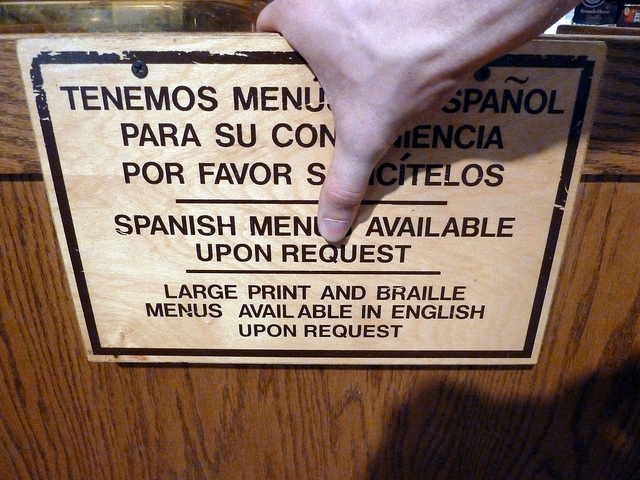Differences between Por and Para
What is Por?
Por is a common preposition in Spanish that most easily translates to for in English. Understanding the purpose of por can be difficult, especially when considering para as well. While memorizing all the rules and cases in which to use por can be tricky, we can simplify por as a preposition that shows the “cause” of the statement we’re looking at.

What is Para?
Para is another Spanish preposition that is usually translated as for or sometimes as in order to. Language learners can often get confused on the different uses of para and por, but para can be differentiated as a preposition that shows the “effect” of the statement in question.

Differences
1) Cause and Effect for Por and Para
Por: In many instances, por indicates the cause or the reason why the subject is doing the action of the sentence. For example, if you are doing something on behalf of someone, you would use por.
Para: Whereas por indicates the reason the subject is doing something, para indicates the effect of what the subject is doing. If you are studying “for” a Spanish test, as an example, you would use para, because the English test is the recipient or your action (studying). In contrast, if you were baking a pie “for” your mother, you would use por, because your mother is the cause of your baking.
2) Motion and Travel for Por and Para
Por: When talking about traveling or movement, por can be used to express how you traveled. To indicate that you used the door to leave or that you flew by plane, you would use por.
Para: Para is used to specify your destination while traveling or moving, not the manner in which you traveled. For instance, you could say “Voy para Tokio (I’m going to Tokyo)” to say where you are going with para.
3) Time Statements for Por and Para
Por: Por is a very useful preposition when talking about actions that take place over time. You can use por to indicate how long you did something for – “por tres horas,” for example. You can also use por when you have an action that is repeated over indefinite time periods, such as when you want to refer to an action you day everyday at a specific time, like eating dinner or doing homework.
Para: The usage of para to indicate time is straightforward. You can use para to indicate a future deadline or time – if you are completing an assignment for next week, as an example.
4) More Uses of Por
In exchange: Por can be used when you are exchanging things and you want to say that you will give something “for” something else.
Means and Manner: Just as por can be used to show how you traveled, it can be used more generally to express the manner in which you did something. If you talk to your grandmother over email, you could say: “Mi abuela y yo comunicamos por email.”
Phrases: Por is used in many common phrases. Some examples are:
- por favor (please)
- por qué (why)
- por ejemplo (for example)
5) More Uses of Para
Goals and Purpose: Similarly to how para can be used to indicate destinations, it can also be used to specify your goal or purpose in doing something. If you want to say you are studying a lot “for” a test, for example, you could use: “Estudio para un examen.”
Phrases: Like por, para also appears in common phrases. A few examples are:
- para siempre (forever)
- para ti (for you)
- para que (so that)
Comparisons and Subject’s Thoughts: If you want to talk about someone or something in comparison to others, you can use para. For example, to say someone writes well “for” her grade, you could use: “Para su grado, escribe bien.” Para can also be used to express opinions, with phrases like “para mi (for me).”
Table of Difference between Por and Para

Summary of Por and Para
- Por and para are both prepositions that can generally be translated as “for.”
- Por has more uses than para and appears more commonly in phrases.
- While both words have many nuanced uses, por can be thought of as indicating the manner in which or reason why you did something, and para as indicating your goal, purpose, or destination in doing something.
- Some Spanish speakers and learners recommend memorizing the rules for para since it’s slightly less common than por, but a successful Spanish learner will study the cases for both words.
- Differences Between Google Fi and T-Mobile - August 18, 2019
- Differences Between LED Bulbs and LED Fixtures - June 1, 2019
- Differences Between McAfee and Kaspersky - April 22, 2019
Search DifferenceBetween.net :
1 Comment
Leave a Response
References :
[0]Uri Quintal. “When To Use “Por” and “Para” In Spanish: The Complete List Of Rules.” italki. November 17, 2014. https://www.italki.com/article/312/when-to-use-por-and-para-in-spanish-the-complete-list-of-rules?hl=en-us.
[1]“Por vs Para.” Enforex. https://www.enforex.com/language/por-para.html.
[2]“”Por” and “Para”.” Study Spanish. Unit Five, Lesson 54. https://studyspanish.com/grammar/lessons/porpara.
[3]“”Por” vs. “Para”.” SpanishDict. https://www.spanishdict.com/guide/por-vs-para.
[4]HYPERLINK "https://www.spanishdict.com/guide/quick-tips-for-understanding-por-and-para."
[5]Image credit: https://commons.wikimedia.org/wiki/File:Spanish_blood_drive_sign_with_some_English.JPG#/media/File:Spanish_blood_drive_sign_with_some_English.JPG
[6]Image credit: https://commons.wikimedia.org/wiki/File:Spanish_blood_drive_sign_with_some_English.JPG#/media/File:Spanish_blood_drive_sign_with_some_English.JPG

With havin so much content and articles do you ever run into any problems of plagorism or copyright violation? My blog has a lot of completely unique content I’ve either authored myself or outsourced but it appears a lot of it is popping it up all over the web without my permission. Do you know any methods to help stop content from being ripped off? I’d truly appreciate it.